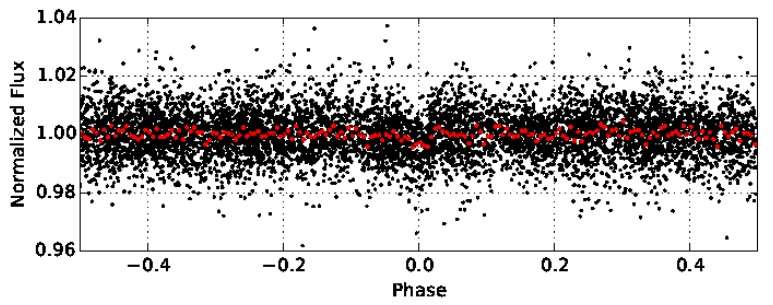August 22, 2016 report
One of the most inflated giant planets discovered

(Phys.org)—An international team of astronomers has detected a highly inflated giant planet orbiting a mildly evolved star. According to a research paper published Aug. 16 on the arXiv pre-print server, the newly found exoplanet, designated KELT-12b, is one of the most inflated "hot Jupiters" known to date.
A giant exoworld that expands in size when its parent star is at the end of its life is called "inflated." This inflation process is very often seen in the so-called "hot Jupiters"—gas giant planets similar in characteristics to the solar system's biggest planet, with orbital periods of less than 10 days. They have high surface temperatures as they orbit their parent stars very closely. The newly discovered KELT-12b is another great example of an inflated "hot Jupiter."
KELT-12b was spotted by a team of researchers led by Daniel Stevens of the Ohio State University. For their observations, the astronomers employed the KELT-North telescope at the Winer Observatory in Arizona. KELT-North is one of the two robotic telescopes in the Kilodegree Extremely Little Telescope (KELT) survey, whose main goal is to search for transiting exoplanets around bright stars.
While analyzing KELT-North data acquired from 2007 to 2013, the scientists identified the initial transit signal of KELT-12b. Afterwards, the team conducted follow-up observations to confirm the planetary nature of this signal. They obtained several high-cadence, high-precision light curves from their global follow-up network of observers and small telescopes.
"We identified the initial transit signal in the KELT-North survey data and established the planetary nature of the companion through precise follow-up photometry, high-resolution spectroscopy, precise radial velocity measurements, and high-resolution adaptive optics imaging," the researchers wrote in the paper.
The newly found alien world is orbiting a mildly evolved, 2 billion-year-old star KELT-12 (also known as TYC 2619-1057-1) that is about 2.4 times larger than our sun and has a mass of approximately 1.59 solar masses. The planet itself, with an orbital period of five days, is slightly less massive than Jupiter, having about 0.95 the mass of the solar system's gas giant. However, its radius is much larger than astronomers have expected – around 1.79 Jupiter radii. This relatively large radius, combined with an extremely low density at a level of just 0.21 g/cm3 indicates that KELT-12b is an inflated exoplanet. Moreover, the scientists emphasize that it is one of the most inflated "hot Jupiters" discovered so far.
As the newest addition to the list of inflated gas giants, KELT-12b data could be helpful in future studies of the inflation process, as it is still unclear what really causes it. In general, the possible explanations could be assigned to two different theories—scientists believe that the inflation is caused by deposition of energy from the host star, or due to inhibited cooling of the planet.
The authors of the paper hope that future studies will greatly expand our catalog of "hot Jupiters" around hot stars, adding new ones with orbital periods longer than a few days. It is expected to put researchers in a better position to investigate any differences in giant planet inflation, which could be crucial to our understanding of this process.
More information: KELT-12b: A P∼5 Day, Highly Inflated Hot Jupiter Transiting a Mildly Evolved Hot Star, arXiv:1608.04714 [astro-ph.EP] arxiv.org/abs/1608.04714
Abstract
We report the discovery of KELT-12b, a highly inflated Jupiter-mass planet transiting a mildly evolved host star. We identified the initial transit signal in the KELT-North survey data and established the planetary nature of the companion through precise follow-up photometry, high-resolution spectroscopy, precise radial velocity measurements, and high-resolution adaptive optics imaging. Our preferred best-fit model indicates that the V=10.64 host, TYC 2619-1057-1, has Teff=6278±51 K, logg⋆=3.89+0.054−0.051, and [Fe/H] = 0.19+0.083−0.085, with an inferred mass M⋆=1.59+0.071−0.091M⊙ and radius R⋆=2.37±0.18R⊙. The planetary companion has MP=0.95±0.14MJ, RP=1.79+0.18−0.17RJ, loggP=2.87+0.097−0.098, and density ρP=0.21+0.075−0.054 g cm−3, making it one of the most inflated giant planets known. The time of inferior conjunction in BJDTDB is 2457088.692055±0.0009 and the period is P=5.0316144±0.0000306 days. Despite the relatively large separation of ∼0.07 AU implied by its ∼5.03-day orbital period, KELT-12b receives significant flux of 2.93+0.33−0.30×109 erg s−1 cm−2 from its host. We compare the radii and insolations of transiting giant planets around hot (Teff≥6250 K) and cool stars, noting that the observed paucity of known transiting giants around hot stars with low insolation is likely due to selection effects. We underscore the significance of long-term ground-based monitoring of hot stars and space-based targeting of hot stars with the Transiting Exoplanet Survey Satellite (TESS) to search for inflated giants in longer-period orbits.
© 2016 Phys.org




















